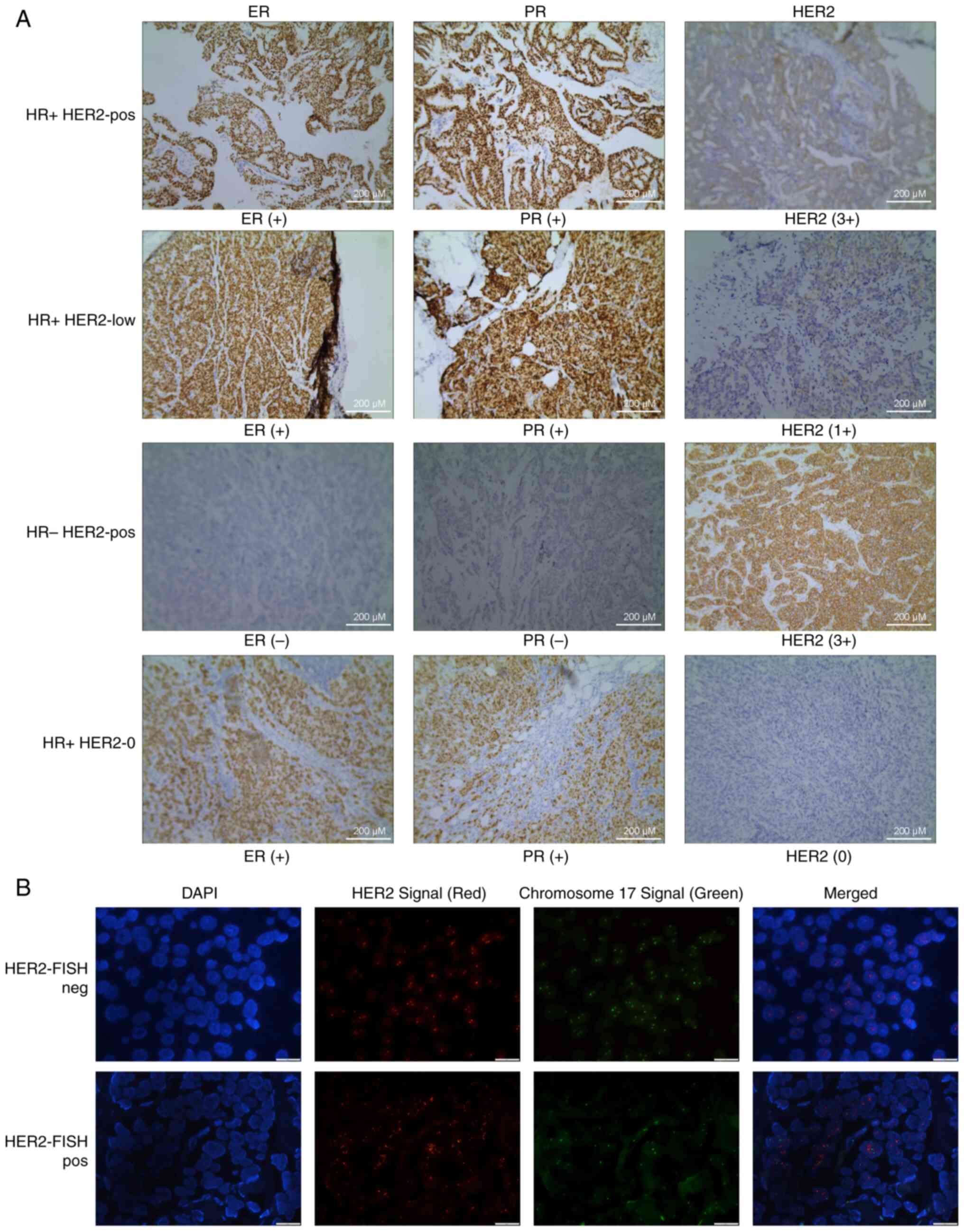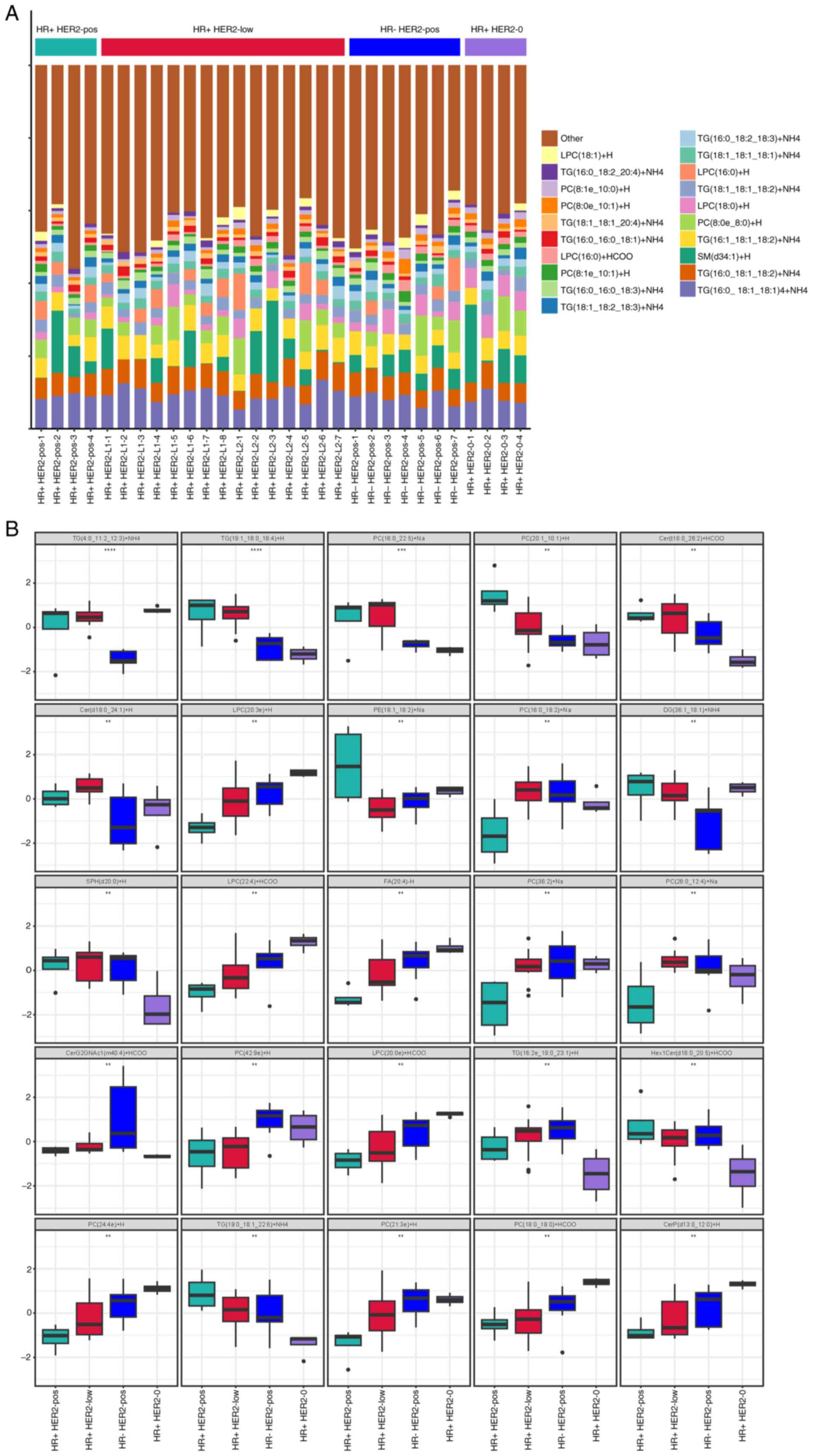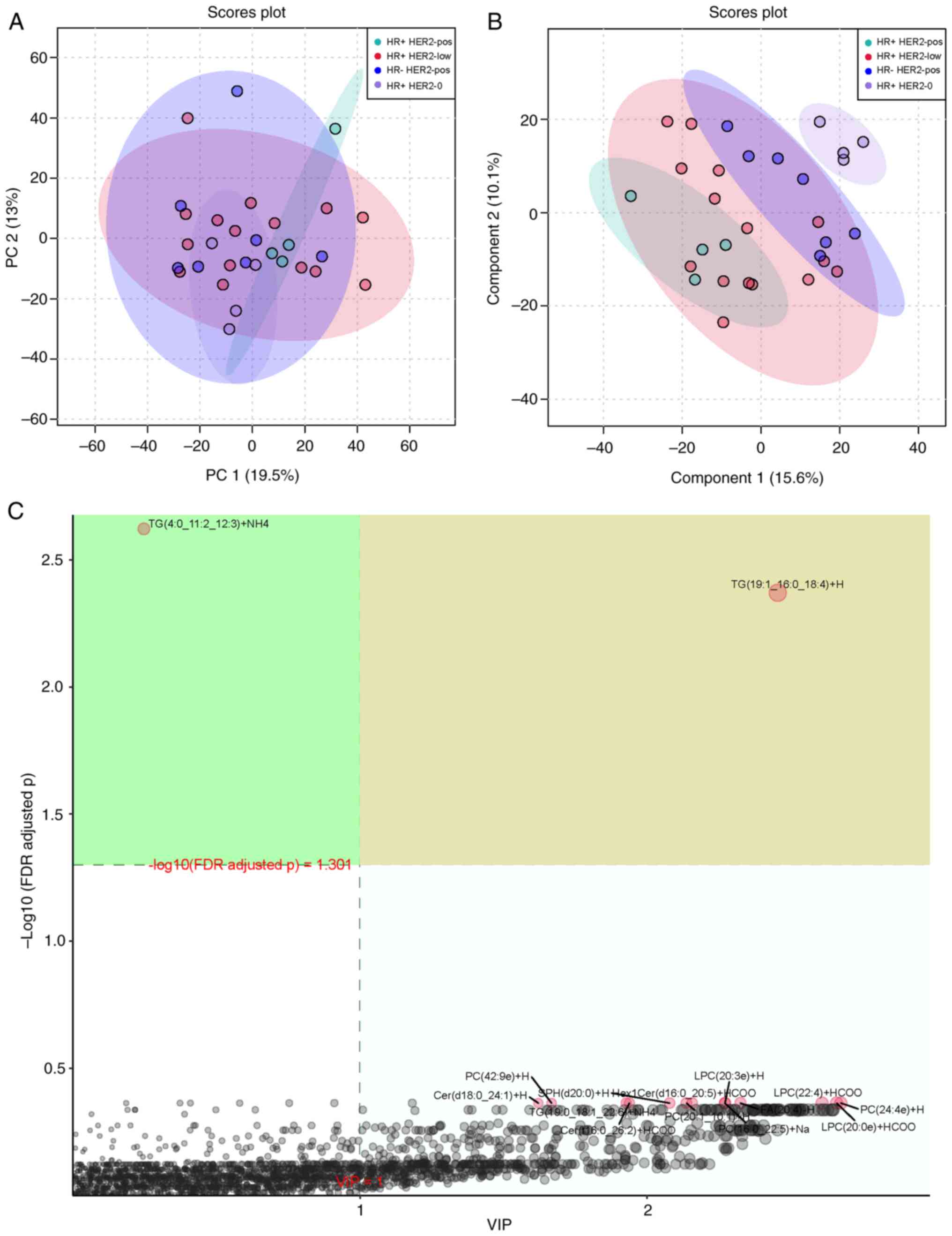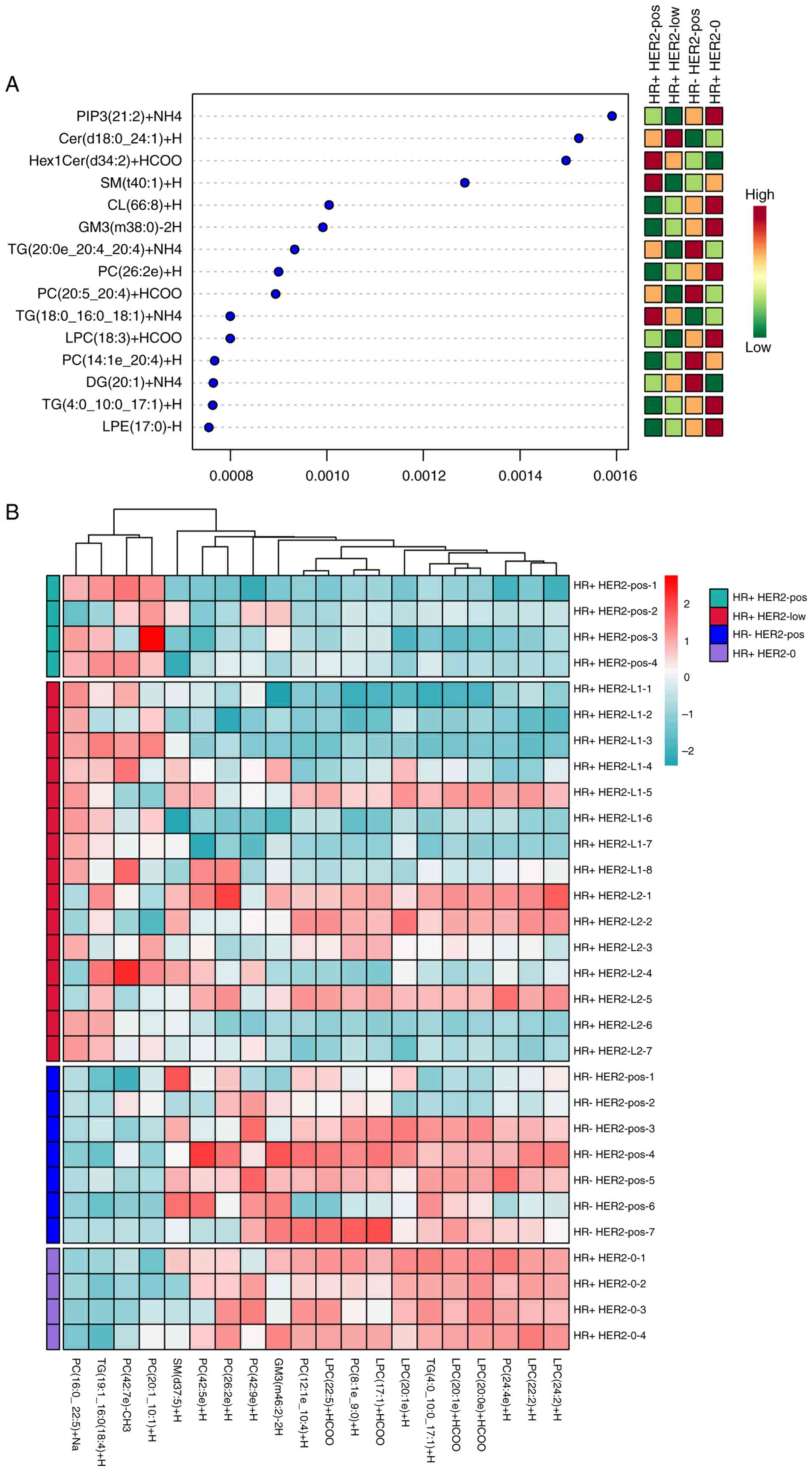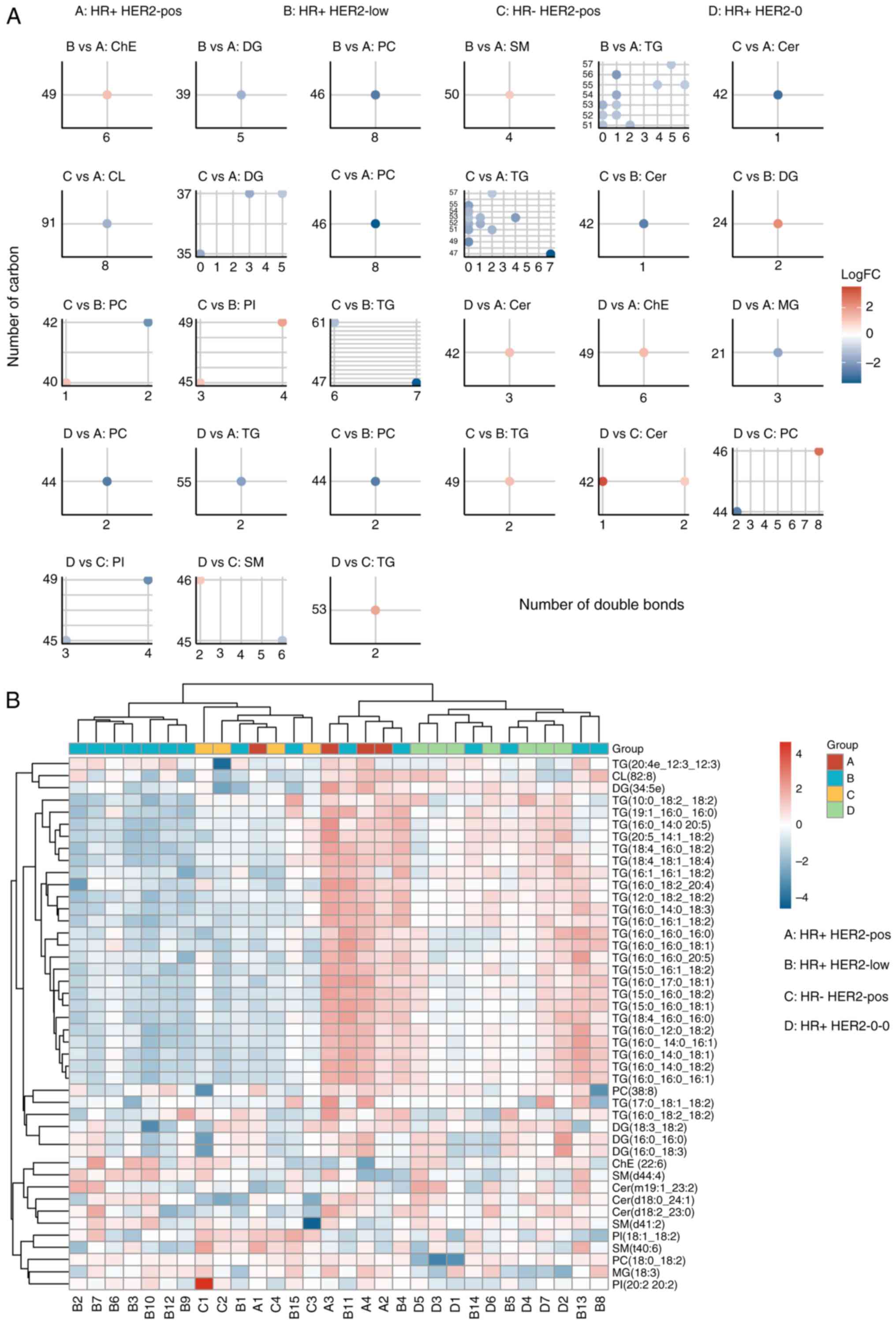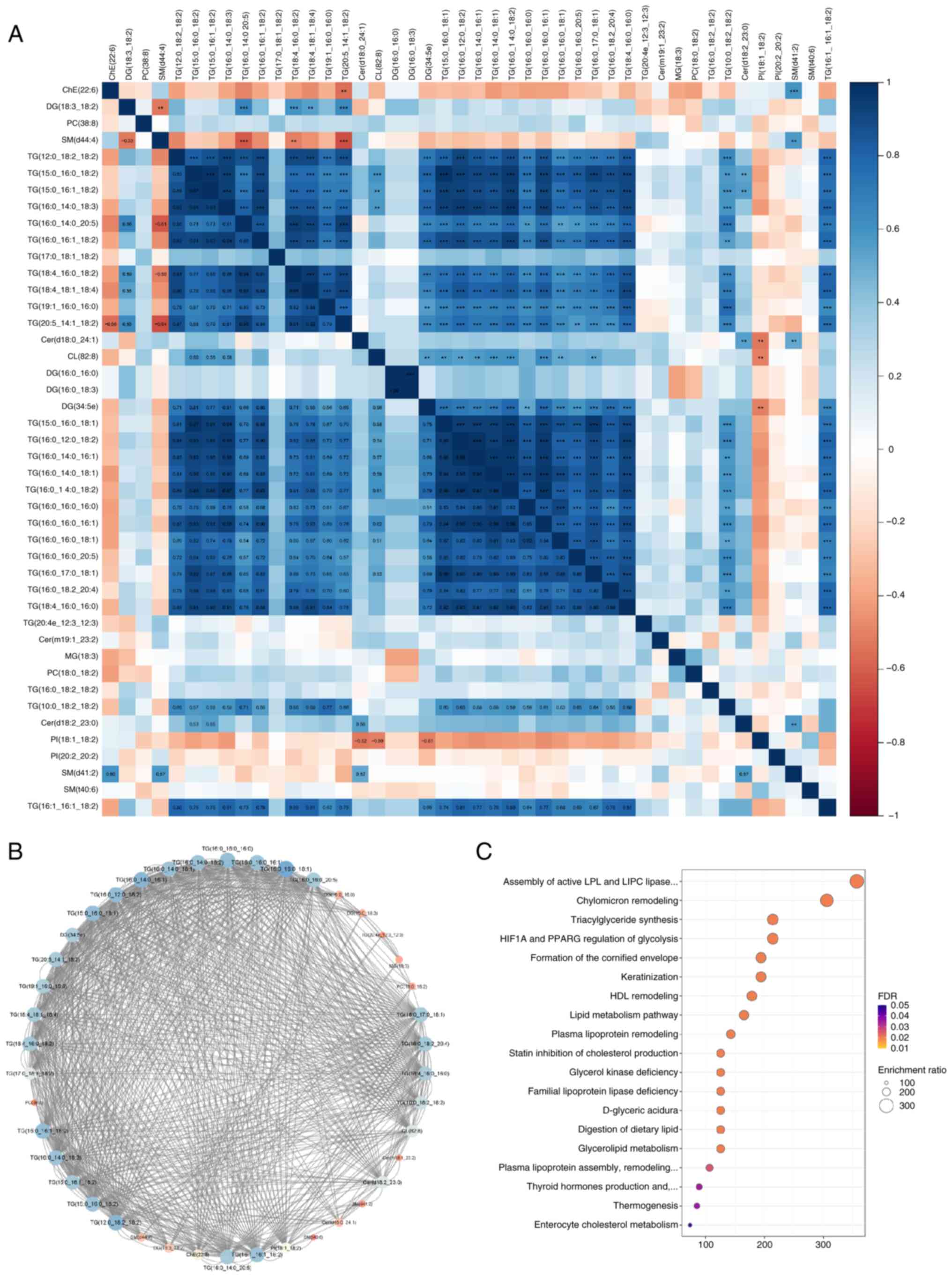Exploring lipidomic profiles and their correlation with hormone receptor and HER2 status in breast cancer
- Authors:
- Published online on: October 29, 2024 https://doi.org/10.3892/ol.2024.14781
- Article Number: 34
-
Copyright: © Qian et al. This is an open access article distributed under the terms of Creative Commons Attribution License.
Abstract
Introduction
Breast cancer is the most prevalent form of cancer among women worldwide, and notably, breast cancer has the highest incidence rate among all cancer types. Furthermore, ~2.26 million [95% uncertainty interval, 2.24–2.79 million] new cases of breast cancer were reported in 2020 worldwide (1). Human epidermal growth factor receptor 2 (HER2), a tyrosine kinase receptor, is intricately linked with cellular proliferation (2–4), metastasis (5–8), invasion (9–12) and angiogenesis (13,14), and is thus often considered a negative prognostic factor for breast cancer. In total, 30–40% of breast cancer cases lack HER2 expression (HER2-0) (15), 15–20% are HER2-positive [including HER2 immunohistochemistry (IHC) 2+ and fluorescence in situ hybridization (FISH) positive or IHC 3+] and 45–55% have low HER2 expression [including HER2 IHC 1+ or IHC 2+ and FISH negative] (16). Thus, breast cancer cases with low HER2 expression represent approximately half of all types, underscoring their growing significance.
Although targeted therapies can improve the quality of life of patients with cancer, anti-HER2 therapies such as trastuzumab, are limited to patients with HER2 + cancer, and thus do not improve the prognoses of patients with low HER2 expression (HER2 IHC 1+ or IHC 2+ and FISH negative) (17,18). Antibody-drug conjugates (ADCs), including trastuzumab deruxtecan (a compound containing an anti-HER2 antibody and a cytotoxic topoisomerase I inhibitor) have expanded the efficacy of targeted treatments for patients with low HER2 expression. ADCs combine the selectivity of targeted therapy with the cytotoxicity of chemotherapy (19). Besides, extensive ongoing and completed research on low HER2 expression has confirmed that novel ADC treatments can benefit these patients, necessitating accurate differentiation between HER2-0 and HER2 1+ and HER2 2+ cases (20–23).
Abnormal lipid metabolism is common in breast cancer, which can impact various biological processes across different cancer subtypes, including hormone receptor (HR)+, HER2 + and triple-negative (24–26). Each subtype exhibits specific and overlapping lipid dependencies. Numerous studies have demonstrated that changes in lipid metabolism influence various aspects of breast cancer, including cell growth, survival, adaptability, resistance to treatment and the ability to spread (27–30). Lipids, which are either non-polar or polar (amphipathic) biomolecules, are synthesized within the cells or absorbed from the surrounding environment (31). Although lipidomic profiles have the potential for predicting and diagnosing breast cancer, numerous challenges remain unresolved, such as sample complexity and heterogeneity, as well as biomarker validation.
The present study aimed to analyze the lipidomic profiles of 30 patients with breast cancer, categorizing the patients into four groups based on the HR and HER2 status. Differences in lipid compositions among the groups were revealed using liquid chromatography-mass spectrometry (LC-MS) and various statistical methods, such as principal component analysis (PCA), partial least squares-discriminant analysis (PLS-DA) and random forest (RF) classification. These findings may enhance the understanding of the link between breast cancer subtypes and lipid metabolic changes as well as provide potential biomarkers and therapeutic targets for breast cancer classification and treatment in the future.
Materials and methods
Study population
The present study was conducted at the Department of Breast and Thyroid Surgery, Shaoxing People's Hospital (Shaoxing, China) between September, 2021 and December, 2023. In total, 30 patients with breast cancer were included in this study. The patients were recruited prospectively and consecutively according to the eligibility criteria as follows: i) Patients with breast cancer confirmed via pathological examination; ii) patients who could withstand study tests; iii) verbal informed consent obtained from the patient, legal representative or responsible caregiver; and iv) patients with a knowledgeable and reliable caregiver accompanying them to all clinic visits during the study. The exclusion criteria were as follows: i) Patients with other severe disease; and ii) patients with comorbidities such as other types of cancer, severe depression, severe renal or hepatic insufficiency and severe cardiac or respiratory failure. The present study followed the relevant principles of the Declaration of Helsinki. The demographic and disease information of the patients was obtained from the medical records, including age, sex, World Health Organization (WHO) grade, Ki67 status, prognosis and lipid profiles were collected from the patients' medical records.
Detection of markers via IHC or FISH
HR status is defined as the presence or absence of the estrogen receptor (ER) and progesterone receptor (PR) on the surface of breast cancer cells. Tumors with these receptors are known as HR+. In the IHC protocol, tissues are first fixed with formaldehyde (10%, room temperature, 24 h), embedded in paraffin and sectioned (5 µm) to create paraffin-embedded slides. These slides are then deparaffinized and rehydrated. Antigen retrieval was performed using a citrate buffer (100°C, 30 min) to enhance antigen binding efficiency. Non-specific binding was minimized by applying 5% goat serum (Beyotime Institute of Biotechnology; cat. no. C0265). Endogenous peroxidase activity was blocked using a hydrogen peroxide solution (2%, 10 min). The slides are subsequently incubated at room temperature for 2 h with primary antibodies targeting ER (Roche Diagnostics; clone: SP1; cat. no. 790-4325), PR (Roche Diagnostics; clone: 1E2; cat. no. 790-4296) or HER2 (Roche Diagnostics; clone: 4B5; cat. no. 790-2991) at a 1:500 dilution, followed by incubation with a secondary antibody with horseradish peroxidase (Thermo Fisher Scientific, Inc.; cat. no. 31430) at room temperature for 30 min at a 1:1,000 dilution. Visualization was achieved using DAB (Roche Diagnostics; cat. no. 760-500) to detect the bound antibodies. An optical microscope (Zeiss AG; OPMI PENTERO 900) was used to observe and collect images, and the HALO platform (version 3.4; Indica Labs, Inc.) was used to analyze the IHC staining. Patients with a HER2 IHC score of 2+ required further testing using FISH.
FISH utilized the same paraffin-embedded sections as IHC, meaning the processes of tissue collection and fixation, paraffin embedding and slide preparation were identical. The HER2 gene test kit (Anbiping Pharmaceutical Technology Co., Ltd.; cat. no. 2408001) was used to further assess HER2 status. Denaturation, hybridization, washing and restaining were performed according to the manufacturer's instructions. The signals were then detected using a fluorescence microscope. A ratio of HER2/chromosome 17 signal was classified as negative, while a ratio ≥2.0 was classified as positive.
Lipidomic profiling
The lipidomic profiles of patients were established through non-targeted LIPIDOMIC studies. The sample was added to water and methyl-tert-butyl ether, followed by vortex mixing. Methanol was then added and the mixture was vortexed again. The mixture underwent ultrasonication for 20 min, incubated at room temperature for 30 min and then centrifuged (14,000 × g, room temperature, 15 min) to collect the supernatant. The organic phase was dried under nitrogen, redissolved in a 90% isopropanol/acetonitrile solution, vortexed and centrifuged (14,000 × g, room temperature, 15 min) again for analysis. The extracted lipids were analyzed using high-throughput LC-MS with an Agilent 1290 liquid chromatography system (Agilent Technologies, Inc.) connected to an Agilent 6550 iFunnel Q-TOF mass spectrometer (Agilent Technologies, Inc.). LC-MS analysis was performed in both positive and negative ion modes to capture comprehensive data to ensure a detailed lipidomic profile. The key parameters of electrospray ionization were as follows: Spray heater gas temperature (nitrogen), 300°C; nebulizer pressure, 30 psi; gas flow rate, 10 l/min.
Statistical analysis
Age differences among the four groups were analyzed using analysis of variance (ANOVA). Post hoc comparisons were conducted using Tukey's HSD test. Other variables such as laterality, World Health Organization (WHO) grade (32) and Ki67 status were evaluated using the Fisher test. WHO grading was used to assess the invasiveness and growth rate of tumors and was classified into grades I to III based on severity. P<0.05 was considered to indicate a statistically significant difference. Lipidomics data were processed and analyzed using the ‘MetaboAnalystR’ package (version 4.0) in R (version 4.3.0; R Foundation for Statistical Computing; http://www.R-project.org/) (33). Differential lipids were identified by integrating P-values from the unpaired t-test, variable importance in projection (VIP) scores from the OPLS-DA model and log fold change (logFC) criteria. The selection criteria were set at P<0.05, VIP ≥1 and logFC ≥1 or logFC ≥-1, to ensure the inclusion of only the most relevant lipids. Lipid pathway enrichment analysis was conducted using the RaMP-DB database (http://github.com/ncats/) (P<0.05), linking differential lipids to potential biological functions. Additionally, the relationships between lipids were assessed using Spearman correlation (P<0.05), visualized in Cytoscape (version 3.9.1; http://cytoscape.org/) (34). Lipid centrality was determined using the cytoHubba plugin, which was used to construct a lipid interaction network diagram.
Results
Patient characteristics
The characteristics of the patients, including age, sex, in situ carcinoma type, lymph node metastasis, HR status and HER2 status are shown in Table I. The 30 patients with breast cancer were divided into four groups based on the HR and HER2 status according to the guidelines for breast cancer diagnosis and treatment by the China Anti-Cancer Association (2024 edition) (35): i) HR+ HER2-0: HR IHC positive, HER2 IHC score of 0; ii) HR+ HER2-low: HR IHC positive, HER2 IHC 1+ or 2+ and FISH negative; iii) HR+ HER2-positive (pos): HR IHC positive, HER2 IHC 3+ or 2+ and FISH positive; and iv) HR- HER2-pos: HR IHC negative, HER2 IHC 3+ or 2+ and FISH positive. Fig. 1A displays representative HR (ER and PR) and HER2 IHC images for the four groups of patients. Fig. 1B displays representative HER2 FISH images (negative and positive). ANOVA (with Tukey's HSD post-hoc test) and Fisher analysis revealed no significant differences in age, laterality or Ki67 status among the four patient groups. However, a significant difference in the distribution of WHO grades was observed among the four groups. Nearly all patients in the HR- HER2-pos group were grade III, whereas grades I–II were more prevalent in the HR+ HER2-low group (Table I). The detailed patient information is listed in Tables SI and SII presents the follow-up data for all patients, including recurrence status and the lipid profiles at the time of the last examination.
Lipidomic landscape
Changes in the lipid composition were detected using high-throughput LC-MS analysis. Specifically, lysophosphatidylcholine (LPC), triglycerides (TGs), phosphatidylcholine (PC) and sphingomyelin (SM) lipids were detected in patient plasma. Fig. 2A provides a detailed display of the distribution of relative abundance of lipid metabolites in all patients, with TG(16:0-18:1-18:1)+NH4, TG(16:0-18:1-18:2)+NH4, SM(d34:1)+H and TG(16:1-18:1-18:2)+NH4 showing higher relative abundances. Furthermore, significant lipid feature differences among the groups were evaluated using ANOVA. The top 25 lipid features among the four groups are shown in Fig. 2B. For instance, significant differences were observed in the levels of TG(4:0-11:2-12:3)+NH4 across the four groups. The levels in the HR- HER2-pos group were notably lower compared with the other groups.
Multivariate statistical analysis
The differences in lipid profiles among the four groups were also assessed using PCA (Fig. 3A) and PLS-DA (Fig. 3B). PCA revealed unique lipid profiles in the HR+ HER2-pos and HR+ HER2-0 groups, while PLS-DA distinguished the four groups. The VIP score plot for PLS-DA indicated that TG(19:1-16:0-18:4)+H [VIP >1; -log10(FDR adjusted P) >1.301] was the metabolite with the greatest impact in the discriminant analysis (Fig. 3C). Figs. S1 and S2 display the PCA and PLS-DA for the six pairwise combinations among the four groups.
Importance and variation analysis
The RF approach highlighted phosphatidylinositol-3,4,5-trisphosphate (PIP3) (21:2)+NH4 as a crucial lipid feature for sample grouping accuracy (Fig. 4A). Fig. S3 displays the importance of different metabolites in distinguishing the six pairwise combinations among the four groups. The results showed that TG(50:13)+NH4, TG(18:3e-18:3-21:1)+Na, PC(36:5)+H, TG(4:0-11:2-12:3)+NH4, TG(18:0-20:4-22:6)+NH4 and DG(16:0-20:4)+H were important for distinguishing HR+ HER2-pos and HR- HER2-low, HR+ HER2-pos and HR- HER2-pos, HR+ HER2-pos and HR+ HER2-0, HR+ HER2-low and HR- HER2-pos, HR+ HER2-low and HR+ HER2-0 as well as HR+ HER2-pos and HR+ HER2-0, respectively. Additionally, the abundance of the top-ranked lipid features is shown in a heatmap, providing a visual representation of lipid feature distribution across groups (Fig. 4B). These analyses were integrated into a single figure to display the importance and abundance variations of the lipid features.
Advanced analysis of the differential lipids
Fatty acids with different carbon chain lengths have different properties and functions. Lipid carbon chain length and the number of double bonds are closely related to lipid oxidation and function (36). The potential oxidation of lipids is lower when the carbon chain is longer or the number of double bonds is lower (37). Herein, only the number of carbon atoms and double bonds of the differential lipids were evaluated to identify significant correlations between the four groups (Fig. 5A). A heatmap based on the classified lipids further explored these relationships, emphasizing the physical and chemical properties of lipids that contribute to lipid group classification (Fig. 5B). The results indicated that TGs, including TG(20:4e-12:3-12:3), TG(10:0-18:2-18:2) and TG(19:1-16:0-16:0), as well as DGs such as DG(34:5e), DG(18:3-18:2) and DG(16:0-18:3), were the most distinct lipids promoting group classifications.
Correlation and pathway enrichment analysis of the differential lipids
A correlation heatmap of the differential lipid classes revealed that specific lipid types were positively correlated with one another (Fig. 6A). Blue and red indicate positive and negative correlations, with deeper shades indicating stronger associations. SMs were negatively correlated with TGs, whereas ceramides were positively correlated with TGs. Network analysis indicated that TGs were extensively correlated with other lipids (Fig. 6B). Pathway enrichment analysis showed that differential lipids were associated with various pathways, particularly the ‘Assembly of active LPL and LIPC lipase complexes’, which had a high fold enrichment and statistical significance (Fig. 6C).
Discussion
Fatty acid metabolism dysregulation plays a crucial role in the malignant transformation of various cancer types (38–42), including breast cancer (43,44). Key metabolic enzymes involved in fatty acid synthesis and oxidation have notable roles in the proliferation, migration and invasion of breast cancer cells (43). Fatty acid metabolism involves multiple pathways, including fatty acid transport, storage in lipid droplets in the form of TGs and cholesterol esters, mobilization from phospholipids and TGs as well as fatty acid oxidation. Most human cells meet their fatty acid requirements by utilizing dietary fatty acids. De novo fatty acid synthesis pathways are only crucial in the liver, breast tissue and adipose tissue (45). The de novo fatty acid synthesis pathway has different roles in normal and cancerous tissues, making it an attractive therapeutic target (38).
A previous review showed that the lipid profile of tumors may be used to distinguish HER2 +, luminal and BRCA-mutated tumors (46). In the present study, distinct lipidomic profiles associated with different breast cancer subtypes, defined by HR and HER2 status, were delineated. The grouping into four groups (HR+ HER2-0, HR+ HER2-low, HR+ HER2-pos and HR- HER2-pos) allowed for a nuanced analysis of how lipidomic landscapes vary with these biomarkers. Notably, the lipid profile diversity, particularly the prevalence of TGs, such as TG(16:0-18:1-18:1)+NH4, underscored the potential biological variance among these groups. Lipid metabolism is involved in cancer biology, influencing various processes, such as cell membrane composition, energy storage and signaling pathways.
A recent study (47) showed that lipidomics-based phenotype heterogeneity can be used to classify cancer types where genetic analysis alone is insufficient. In the present study, the composition of PCs and TGs and their relationships with the HR/HER2 phenotypes in breast cancer were discovered. The results also underscored the significance of TGs, while indicating that DGs are less important. The correlation and pathway enrichment analyses indicated the broader biological implications of the study findings. The clustering heatmap and network analysis of differential lipids highlighted interconnected lipid metabolism pathways, particularly the assembly of active lipase complexes. Such pathways are crucial for lipid processing and can be integral in understanding the metabolic reprogramming in cancer cells. A recent study (48) indicated that lipoprotein lipase is associated with poor prognosis in breast cancer, indicating that the LPC pathway is crucial in breast cancer.
The present study still has certain limitations that cannot be ignored, which should be addressed in future larger cohorts and longitudinal designs. First, it must be acknowledged that the small sample size is a significant limitation, rendering the present study a pilot study. Although some key lipids have been identified in the present study, the relatively small number of samples limits the statistical power and generalizability, preventing a direct assessment of how these specific lipids influence breast cancer cells. Larger cohorts are necessary to validate the potential of lipidomic analysis in the clinical context of breast cancer. To further understand the direct effects of these lipids, we plan to examine their roles in regulating cell proliferation, migration and invasion using breast cancer cell lines with different HR/HER2 phenotypes, thereby potentially identifying novel therapeutic targets. Furthermore, exploring the correlation between lipid profiles and clinical outcomes is essential. The lipid profiles and clinical outcomes of patients are shown in Table SII; however, the small sample size limits the validity of further analysis of the relationship between these two characteristics. The preliminary results of the present study provide valuable insights into the metabolic variations across different subtypes of breast cancer. Therefore, our future research will focus on examining the relationships and differences between lipid profiles and survival outcomes across various breast cancer subtypes.
In summary, several lipid molecules were significantly different and could be used to distinguish between breast cancer groups based on the HR and HER2 status. These key lipid features include: i) TG: TG(16:0-18:1-18:1)+NH4, prominent lipid composition; TG(16:0-18:1-18:2)+NH4, another major lipid composition; TG(16:1-18:1-18:2)+NH4, featured prominently in lipidomic profiles; TG(50:13)+NH4, important for distinguishing between the HR+ HER2-pos and HR+ HER2-low groups; TG(18:3e-18:3-21:1)+Na, crucial for distinguishing between the HR+ HER2-pos and HR- HER2-pos groups; TG(4:0-11:2-12:3)+NH4, significant for distinguishing between the HR+ HER2-low and HR- HER2-pos groups; TG(18:0-20:4-22:6)+NH4, important for distinguishing between the HR+ HER2-low and HR+ HER2-0 groups; TG(20:4e-12:3-12:3), TG(10:0-18:2-18:2) and TG(19:1-16:0-16:0), distinct lipids for group classifications based on carbon chain length and the number of double bonds. ii) PC: PC(36:5)+H, important for distinguishing between HR+ HER2-pos and HR+ HER2-0 groups. iii) SM: SM (d34:1)+H, prominent lipid feature in HR+ HER2-0 group. iv) DG: DG(16:0-20:4)+H, significant for distinguishing between the HR+ HER2-pos and HR+ HER2-0 groups; DG(34:5e), DG(18:3-18:2) and DG(16:0-18:3), most distinct DGs for group classifications. v) PIP: PIP3(21:2)+NH4, crucial lipid feature for sample grouping accuracy.
In conclusion, the comprehensive analysis of lipidomic variations across different breast cancer subtypes offers valuable insights into the metabolic alterations associated with cancer progression and phenotype. Therefore, the findings of the present study may improve the development of tailored therapeutic strategies that target specific metabolic pathways in breast cancer.
Supplementary Material
Supporting Data
Supporting Data
Acknowledgements
Not applicable.
Funding
This study was supported by the Shaoxing Public Welfare Application Research Program Project (grant no. 2020A13009).
Availability of data and materials
The lipidomics data generated in the present study may be found in the MetaboLights repository under the accession number MTBLS10858 or at the following URL: https://www.ebi.ac.uk/metabolights/MTBLS10858. All other data generated in the present study may be requested from the corresponding author.
Authors' contributions
XQ was responsible for data curation and formal analysis, ensuring accurate data representation and preliminary analysis. JH and XJ managed the methods and project implementation, selecting and implementing appropriate analytical techniques to ensure smooth progress of the project. JZ handled the validation process, critically assessing the accuracy and reliability of the data and analyses. SH (the corresponding author), conceptualized the study, developed the methodology and led the manuscript writing, framing the study's findings within the broader context of lipid metabolism and cancer progression. All authors read and approved the final version of the manuscript. XQ and SH confirm the authenticity of all the raw data.
Ethics approval and consent to participate
This study was approved by the Ethics Committee of Shaoxing People's Hospital (Shaoxing, China; approval no. 2021-K-Y-53-01), and the study followed relevant guidelines and regulations. Verbal informed consent was obtained from all individual participants involved in the study, and the requirement for written informed consent was waived by the Ethics Committee.
Patient consent for publication
Not applicable.
Competing interests
The authors declare that they have no competing interests.
Glossary
Abbreviations
Abbreviations:
|
ADC |
antibody-drug conjugates |
|
ANOVA |
analysis of variance |
|
DG |
diacylglycerol |
|
FISH |
fluorescence in situ hybridization |
|
HER2 |
human epidermal growth factor receptor 2 |
|
HR |
hormone receptor |
|
IHC |
immunohistochemistry |
|
LC-MS |
liquid chromatography-mass spectrometry |
|
LPC |
lysophosphatidylcholine |
|
PC |
phosphatidylcholine |
|
PCA |
principal component analysis |
|
PIP3 |
phosphatidylinositol-3,4,5-trisphosphate |
|
PLS-DA |
partial least squares discriminant analysis |
|
SM |
sphingomyelin |
|
TG |
triglycerides |
|
VIP |
variable importance in projection |
References
|
Ferlay J, Ervik M, Lam F, Laversanne M, Colombet M, Mery L, Piñeros M, Znaor A, Soerjomataram I and Bray F: Global cancer observatory: Cancer today. International Agency for Research on Cancer; Lyon: 2020 | |
|
Wolf-Yadlin A, Kumar N, Zhang Y, Hautaniemi S, Zaman M, Kim HD, Grantcharova V, Lauffenburger DA and White FM: Effects of HER2 overexpression on cell signaling networks governing proliferation and migration. Mol Syst Biol. 2:542006. View Article : Google Scholar : PubMed/NCBI | |
|
Eladdadi A and Isaacson D: A mathematical model for the effects of HER2 overexpression on cell proliferation in breast cancer. Bull Math Biol. 70:1707–1729. 2008. View Article : Google Scholar : PubMed/NCBI | |
|
Tagliabue E, Agresti R, Carcangiu ML, Ghirelli C, Morelli D, Campiglio M, Martel M, Giovanazzi R, Greco M, Balsari A and Ménard S: Role of HER2 in wound-induced breast carcinoma proliferation. Lancet. 362:527–533. 2003. View Article : Google Scholar : PubMed/NCBI | |
|
Freudenberg JA, Wang Q, Katsumata M, Drebin J, Nagatomo I and Greene MI: The role of HER2 in early breast cancer metastasis and the origins of resistance to HER2-targeted therapies. Exp Mol Pathol. 87:1–11. 2009. View Article : Google Scholar : PubMed/NCBI | |
|
Li YM, Pan Y, Wei Y, Cheng X, Zhou BP, Tan M, Zhou X, Xia W, Hortobagyi GN, Yu D and Hung MC: Upregulation of CXCR4 is essential for HER2-mediated tumor metastasis. Cancer Cell. 6:459–469. 2004. View Article : Google Scholar : PubMed/NCBI | |
|
Harris C, Ward R, Dobbins T, Drew A and Pearson S: The efficacy of HER2-targeted agents in metastatic breast cancer: A meta-analysis. Ann Oncol. 22:1308–1317. 2011. View Article : Google Scholar : PubMed/NCBI | |
|
Lin NU and Winer EP: Brain metastases: The HER2 paradigm. Clin Cancer Res. 13:1648–1655. 2007. View Article : Google Scholar : PubMed/NCBI | |
|
Merkhofer EC, Cogswell P and Baldwin AS: Her2 activates NF-kappaB and induces invasion through the canonical pathway involving IKKalpha. Oncogene. 29:1238–1248. 2010. View Article : Google Scholar : PubMed/NCBI | |
|
Luo X, He Y, Tang H, Cao Y, Gao M, Liu B and Hu Z: Effects of HER2 on the invasion and migration of gastric cancer. Am J Transl Res. 11:7604–7613. 2019.PubMed/NCBI | |
|
Al-Juboori SI, Vadakekolathu J, Idri S, Wagner S, Zafeiris D, Pearson J, Almshayakhchi R, Caraglia M, Desiderio V, Miles AK, et al: PYK2 promotes HER2-positive breast cancer invasion. J Exp Clin Cancer Res. 38:1–14. 2019. View Article : Google Scholar : PubMed/NCBI | |
|
Chi F, Wu R, Jin X, Jiang M and Zhu X: HER2 induces cell proliferation and invasion of non-small-cell lung cancer by upregulating COX-2 expression via MEK/ERK signaling pathway. Onco Targets Ther. 5:2709–2716. 2016.PubMed/NCBI | |
|
Alameddine RS, Otrock ZK, Awada A and Shamseddine A: Crosstalk between HER2 signaling and angiogenesis in breast cancer: Molecular basis, clinical applications and challenges. Curr Opin Oncol. 25:313–324. 2013. View Article : Google Scholar : PubMed/NCBI | |
|
Vogl G, Bartel H, Dietze O and Hauser-Kronberger C: HER2 is unlikely to be involved in directly regulating angiogenesis in human breast cancer. Appl Immunohistochem Mol Morphol. 14:138–145. 2006. View Article : Google Scholar : PubMed/NCBI | |
|
Tarantino P, Hamilton E, Tolaney SM, Cortes J, Morganti S, Ferraro E, Marra A, Viale G, Trapani D, Cardoso F, et al: HER2-low breast cancer: Pathological and clinical landscape. J Clin Oncol. 38:1951–1962. 2020. View Article : Google Scholar : PubMed/NCBI | |
|
Yan M, Schwaederle M, Arguello D, Millis SZ, Gatalica Z and Kurzrock R: HER2 expression status in diverse cancers: Review of results from 37,992 patients. Cancer Metastasis Rev. 34:157–164. 2015. View Article : Google Scholar : PubMed/NCBI | |
|
Maximiano S, Magalhaes P, Guerreiro MP and Morgado M: Trastuzumab in the treatment of breast cancer. BioDrugs. 30:75–86. 2016. View Article : Google Scholar : PubMed/NCBI | |
|
Vu T and Claret FX: Trastuzumab: Updated mechanisms of action and resistance in breast cancer. Front Oncol. 2:622012. View Article : Google Scholar : PubMed/NCBI | |
|
Modi S, Jacot W, Yamashita T, Sohn J, Vidal M, Tokunaga E, Tsurutani J, Ueno NT, Prat A, Chae YS, et al: Trastuzumab deruxtecan in previously treated HER2-low advanced breast cancer. N Engl J Med. 387:9–20. 2022. View Article : Google Scholar : PubMed/NCBI | |
|
Skidmore L, Sakamuri S, Knudsen NA, Hewet AG, Milutinovic S, Barkho W, Biroc SL, Kirtley J, Marsden R, Storey K, et al: ARX788, a site-specific anti-HER2 antibody-drug conjugate, demonstrates potent and selective activity in HER2-low and T-DM1-resistant breast and gastric cancers. Mol Cancer Ther. 19:1833–1843. 2020. View Article : Google Scholar : PubMed/NCBI | |
|
Ogitani Y, Aida T, Hagihara K, Yamaguchi J, Ishii C, Harada N, Soma M, Okamoto H, Oitate M, Arakawa S, et al: DS-8201a, a novel HER2-targeting ADC with a novel DNA Topoisomerase I inhibitor, demonstrates a promising antitumor efficacy with differentiation from T-DM1. Clin Cancer Res. 22:5097–5108. 2016. View Article : Google Scholar : PubMed/NCBI | |
|
Dai LJ, Ma D, Xu YZ, Li M, Li YW, Xiao Y, Jin X, Wu SY, Zhao YX, Wang H, et al: Molecular features and clinical implications of the heterogeneity in Chinese patients with HER2-low breast cancer. Nat Commun. 14:51122023. View Article : Google Scholar : PubMed/NCBI | |
|
de Nonneville A, Houvenaeghel G, Cohen M, Sabiani L, Bannier M, Viret F, Gonçalves A and Bertucci F: Pathological complete response rate and disease-free survival after neoadjuvant chemotherapy in patients with HER2-low and HER2-0 breast cancers. Eur J Cancer. 176:181–188. 2022. View Article : Google Scholar : PubMed/NCBI | |
|
Liu L, Kawashima M, Sugimoto M, Sonomura K, Pu F, Li W, Takeda M, Goto T, Kawaguchi K, Sato TA and Toi M: Discovery of lipid profiles in plasma-derived extracellular vesicles as biomarkers for breast cancer diagnosis. Cancer Sci. 114:4020–4031. 2023. View Article : Google Scholar : PubMed/NCBI | |
|
Vitaliti A, Roccatani I, Iorio E, Perta N, Gismondi A, Chirico M, Pisanu ME, Di Marino D, Canini A, De Luca A and Rossi L: AKT-driven epithelial-mesenchymal transition is affected by copper bioavailability in HER2 negative breast cancer cells via a LOXL2-independent mechanism. Cell Oncol (Dordr). 46:93–115. 2023. View Article : Google Scholar : PubMed/NCBI | |
|
Xiao Y, Ma D, Yang YS, Yang F, Ding JH, Gong Y, Jiang L, Ge LP, Wu SY, Yu Q, et al: Comprehensive metabolomics expands precision medicine for triple-negative breast cancer. Cell Res. 32:477–490. 2022. View Article : Google Scholar : PubMed/NCBI | |
|
Li S, Zeng H, Fan J, Wang F, Xu C, Li Y, Tu J, Nephew KP and Long X: Glutamine metabolism in breast cancer and possible therapeutic targets. Biochem Pharmacol. 210:1154642023. View Article : Google Scholar : PubMed/NCBI | |
|
Shen L, Huang H, Li J, Chen W, Yao Y, Hu J, Zhou J, Huang F and Ni C: Exploration of prognosis and immunometabolism landscapes in ER+ breast cancer based on a novel lipid metabolism-related signature. Front Immunol. 14:11994652023. View Article : Google Scholar : PubMed/NCBI | |
|
Azam A and Sounni NE: Lipid metabolism heterogeneity and crosstalk with mitochondria functions drive breast cancer progression and drug resistance. Cancers (Basel). 14:62672022. View Article : Google Scholar : PubMed/NCBI | |
|
Zipinotti Dos Santos D, de Souza JC, Pimenta TM, da Silva Martins B, Junior RSR, Butzene SMS, Tessarolo NG, Cilas PML Jr, Silva IV and Rangel LBA: The impact of lipid metabolism on breast cancer: A review about its role in tumorigenesis and immune escape. Cell Commun Signal. 21:1612023. View Article : Google Scholar : PubMed/NCBI | |
|
Ward AV, Anderson SM and Sartorius CA: Advances in analyzing the breast cancer lipidome and its relevance to disease progression and treatment. J Mammary Gland Biol Neoplasia. 26:399–417. 2021. View Article : Google Scholar : PubMed/NCBI | |
|
World Health Organization (WHO), . WHO classification of tumours editorial board: Breast tumours. WHO; Geneva: 2019 | |
|
Chong J, Soufan O, Li C, Caraus I, Li S, Bourque G, Wishart DS and Xia J: MetaboAnalyst 4.0: Towards more transparent and integrative metabolomics analysis. Nucleic Acids Res. 46:W486–W494. 2018. View Article : Google Scholar : PubMed/NCBI | |
|
Duan Y, Du Y, Gu Z, Zheng X and Wang C: prognostic value, immune signature, and molecular mechanisms of the PHLDA family in pancreatic adenocarcinoma. Int J Mol Sci. 23:103162022. View Article : Google Scholar : PubMed/NCBI | |
|
Breast Cancer Professional Committee of the Chinese Anti-Cancer Association and Breast Tumor Group of the Oncology Branch of the Chinese Medical Association, . Guidelines for breast cancer diagnosis and treatment by China Anti-cancer Association (2024 edition) (Chinese version). China Oncology. 33:1092–1187. 2023. | |
|
Zhang R, Yang M, Hou X, Hou R, Wang L, Shi L, Zhao F, Liu X, Meng Q, Wang L and Zhang L: Characterization and difference of lipids and metabolites from Jianhe White Xiang and Large White pork by high-performance liquid chromatography-tandem mass spectrometry. Food Res Int. 162:1119462022. View Article : Google Scholar : PubMed/NCBI | |
|
Zhang Z, Liao Q, Sun Y, Pan T, Liu S, Miao W, Li Y, Zhou L and Xu G: Lipidomic and transcriptomic analysis of the longissimus muscle of luchuan and duroc pigs. Front Nutr. 8:6676222021. View Article : Google Scholar : PubMed/NCBI | |
|
Koundouros N and Poulogiannis G: Reprogramming of fatty acid metabolism in cancer. Br J Cancer. 122:4–22. 2020. View Article : Google Scholar : PubMed/NCBI | |
|
Yousuf U, Sofi S, Makhdoomi A and Mir MA: Identification and analysis of dysregulated fatty acid metabolism genes in breast cancer subtypes. Med Oncol. 39:2562022. View Article : Google Scholar : PubMed/NCBI | |
|
Zhang F and Du G: Dysregulated lipid metabolism in cancer. World J Biol Chem. 3:167–174. 2012. View Article : Google Scholar : PubMed/NCBI | |
|
Wang M, Han J, Xing H, Zhang H, Li Z, Liang L, Li C, Dai S, Wu M, Shen F and Yang T: Dysregulated fatty acid metabolism in hepatocellular carcinoma. Hepat Oncol. 3:241–251. 2016. View Article : Google Scholar : PubMed/NCBI | |
|
Zhou X, Huang F, Ma G, Wei W, Wu N and Liu Z: Dysregulated ceramides metabolism by fatty acid 2-hydroxylase exposes a metabolic vulnerability to target cancer metastasis. Signal Transduct Target Ther. 7:3702022. View Article : Google Scholar : PubMed/NCBI | |
|
Monaco ME: Fatty acid metabolism in breast cancer subtypes. Oncotarget. 8:29487–29500. 2017. View Article : Google Scholar : PubMed/NCBI | |
|
Qin L, An N, Yuan B, Zhu Q and Feng Y: The metabolomic characteristics and dysregulation of fatty acid esters of hydroxy fatty acids in breast cancer. Metabolites. 13:11082023. View Article : Google Scholar : PubMed/NCBI | |
|
Weiss L, Hoffmann GE, Schreiber R, Andres H, Fuchs E, Körber E and Kolb HJ: Fatty-acid biosynthesis in man, a pathway of minor importance. Purification, optimal assay conditions, and organ distribution of fatty-acid synthase. Biol Chem Hoppe Seyler. 367:905–912. 1986. View Article : Google Scholar : PubMed/NCBI | |
|
Ribas HT, Sogayar MC, Dolga AM, Winnischofer SM and Trombetta-Lima M: Lipid profile in breast cancer: From signaling pathways to treatment strategies. Biochimie. 219:118–129. 2023. View Article : Google Scholar | |
|
Aramaki S, Tsuge S, Islam A, Eto F, Sakamoto T, Oyama S, Li W, Zhang C, Yamaguchi S, Takatsuka D, et al: Lipidomics-based tissue heterogeneity in specimens of luminal breast cancer revealed by clustering analysis of mass spectrometry imaging: A preliminary study. PLoS One. 18:e02831552023. View Article : Google Scholar : PubMed/NCBI | |
|
Bavis MM, Nicholas AM, Tobin AJ, Christian SL and Brown RJ: The breast cancer microenvironment and lipoprotein lipase: Another negative notch for a beneficial enzyme? FEBS Open Bio. 13:586–596. 2023. View Article : Google Scholar : PubMed/NCBI |



